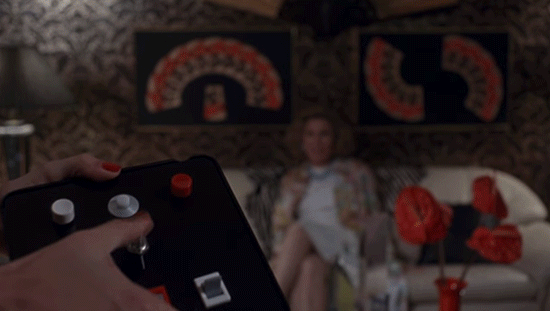The Story Behind the Insane Decor in GoodFellas
One of my favorite moments in GoodFellas comes late in the film, when Henry and Karen Hill are finally flush with cocaine money and use the opportunity to proudly show off their new home. The furniture is mostly gleaming black lacquer, with gold and black filigree wallpaper to match. There’s a zebra print throw flung over the couch, multiple ornamental fans, and splashes of fire engine red for good measure. Even the plants are somehow metallic. It looks like it was designed by two people on, well, a ton of cocaine. That is, until you get to the pièce de résistance: a large plastic wall made to look like stone overlaid with shards of colored glass, which opens to reveal a television console and liquor cabinet with the push of a button. That part looks like it was designed by a thirteen-year-old on cocaine.

Though mob decor is typically portrayed as ostentatious—saran-wrapped gilded couches, plentiful Catholic memorabilia—this takes the concept to a whole new level. “We wanted everything to be understated until Henry Hill went nuts,” production designer Kristi Zea told me. Zea, whose prolific resume includes stints on Silence of the Lambs and The Departed, was hired on GoodFellas after working with director Martin Scorsese on the 1989 anthology New York Stories. For the film’s 30th anniversary, I called her to ask approximately 600 questions about the rock wall.
“I felt like I was working with the Pope of the mafia world,” Zea tells me of Scorsese. “He was raised in Little Italy, and had a very clear idea of what he wanted.” At the time, Zea was fresh off the Jonathan Demme comedy Married to the Mob. “[Scorsese] said to me something along the lines of, ‘Married to the Mob should never have been done by Jonathan Demme. It should have been done by an Italian,’” she adds. “So I already thought, Uh oh.”
Her process involved scouting various locations, mostly around Queens and Brooklyn, and sending them to Scorsese for approval. For each interior, she would create a concept board with photographs and an artist’s rendering of what she was hoping to accomplish. While much of the decor was inspired by research she did of actual mob families, that final house was “complete fiction.”
It was located in Fort Lee, New Jersey, while the furniture was sourced from a since-closed store called Roma Furniture on the Lower East Side that Zea had come across through her previous job as a prop stylist. “I would just think, Oh my God, who buys this kind of furniture?” she says. She snapped some pictures of the lacquered goods and showed them to Scorsese explaining her vision. “And he said, ‘Okay, okay. Okay. All right. All right, all right,’” Zea recalls. “I was really walking on some fine line, but I think he allowed for it because it was supposed to be ridiculous, in a way.”
She was inspired in part by an Amy Arbus photography book. “It was portraits of people in their homes, mostly in Long Island and New Jersey and Queens,” Zea says. “There was an aesthetic that I really embraced. That’s the direction that I went in for the last location.”
And then, of course, we must address the rock wall in the room: definitely the most outrageous piece of cinematic criminal decor since the in-ground bathtub in Scarface, and possibly a recycled prop from Legends of the Hidden Temple. “I mean, it was ridiculous. I don't know. I just thought it would be really amusing,” she says. “I think it was sort of like Ali Baba and the Forty Thieves. Marty just said, ‘Yeah. Yeah, definitely. That's fine.’” It was assembled specially for the film and was actually battery operated.
While lacquer was a popular eighties design trend, and one that I’ve started to see crop up at vintage furniture shops, I sadly haven’t encountered too many sliding rock walls in my time. I ask Zea if it’s something she ever came across in any real properties. “I'm afraid that came out of my imagination,” she laughs. Although, Zea adds, it does remind her of the cave-themed rooms at the famed Madonna Inn in California.
“There was something ecclesiastical about the stained glass,” she adds. “That was their altar to wealth and success.”
What do you do after starring on The Sopranos, arguably the greatest television show of all time? If you’re Michael Imperioli, a little bit of everything.
Originally Appeared on GQ


